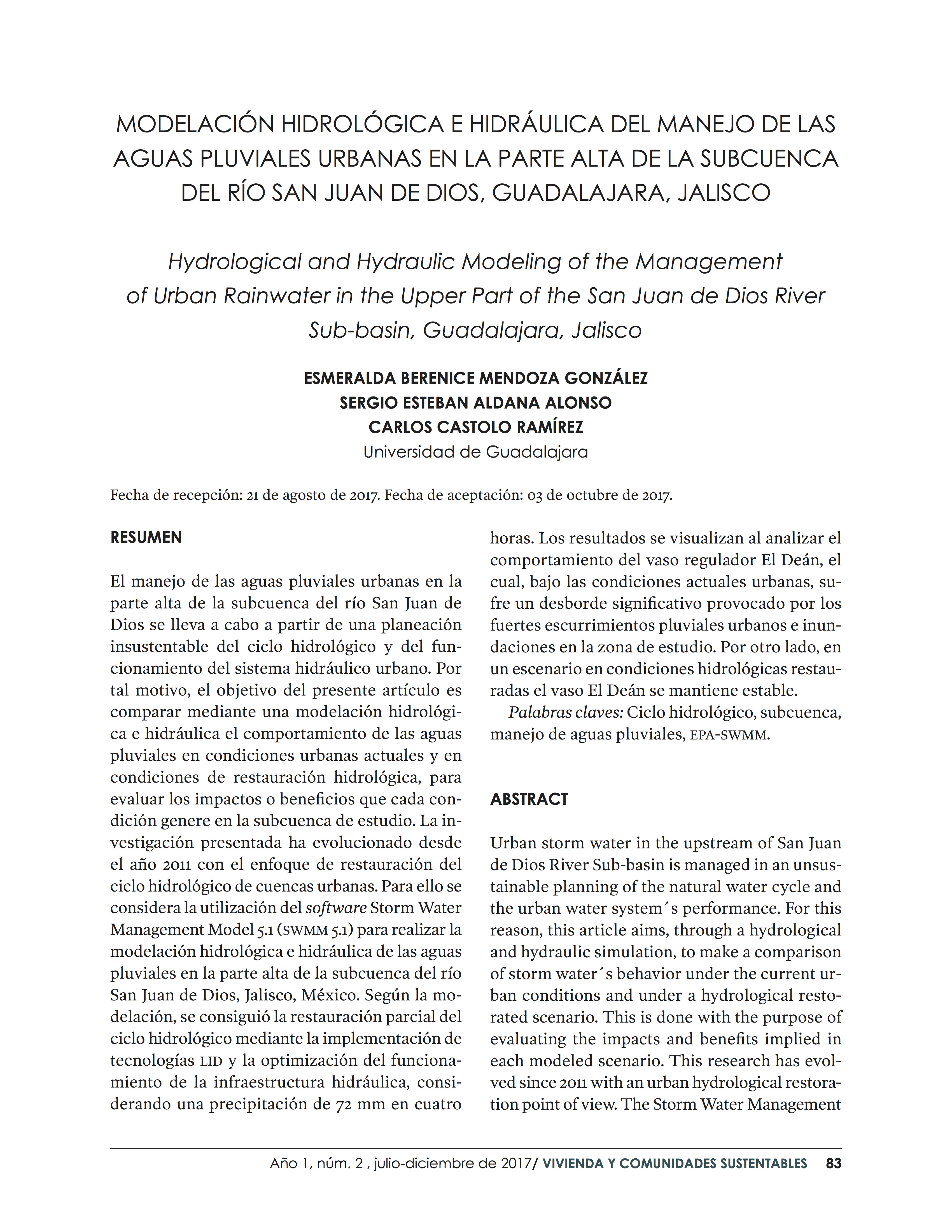Modelación hidrológica e hidráulica del manejo de las aguas pluviales urbanas en la parte alta de la subcuenca del río San Juan de Dios, Guadalajara, Jalisco
DOI:
https://doi.org/10.32870/rvcs.v0i2.22Palabras clave:
ciclo hidrológico, cuenca, manejo de aguas pluviales, EPA-SWMMResumen
El manejo de las aguas pluviales urbanas en la parte alta de la subcuenca del río San Juan de Dios se lleva a cabo a partir de una planeación insustentable del ciclo hidrológico y del funcionamiento del sistema hidráulico urbano. Por tal motivo, el objetivo del presente artículo es realizar una modelación hidrológica e hidráulica de las aguas pluviales en las actuales condiciones urbanas y en condiciones de restauración hidrológica de cuencas urbanas. Esto con el fin de evaluar los impactos o beneficios que cada escenario genera en la subcuenca de estudio. La investigación presentada ha evolucionado desde el año 2011 con el enfoque de restauración del ciclo hidrológico de cuencas urbanas. Para ello se considera la utilización del software Storm Water Management Model 5.1 (SWMM 5.1) para realizar la modelación hidrológica e hidráulica de las aguas pluviales en la parte alta de la subcuenca del río San Juan de Dios, Jalisco, México.Métricas
Citas
Abi Aad M., Suidan M. y Shuster W. (2010). "Modeling Techniques of Best Management Practices: Rain Barrels and Rain Gardens Using epa swmm-5". Journal of Hydrologic Engineering, pp. 434-443.
https://doi.org/10.1061/(ASCE)HE.1943-5584.0000136
Álvarez Díaz, C. (1996). "Aportaciones metodológicas al estudio de la contaminación litoral originadas por vertidos y alivios procedentes de redes de saneamiento urbano".
American Society of Civil Engineers (ASCE) y Water Environment Federation (WEF) (1992). "Design and Construction of Urban Stormwater Management Systems", ASCE Manuals y Reports of Engineering Practice, núm. 77, WEF Manual of Practice FD-20. Nueva York.
Andrade , Á. (2004). Lineamientos para la aplicación del enfoque ecosistématico a la gestión integral del recurso hídrico. Ciudad de México: PNUMA.
Arden, S., Ma, X., y Brown, M. (2014). "An Ecohydrologic Model for a Shallow Groundwater Urban "environment". Water Science et Technology, pp. 1789-1797.
https://doi.org/10.2166/wst.2014.299
Bezerra E., Silva C., Leite M. y Koide S. (2017). "Analysis of the Urbanization Evolution E ect on Runo Using swmm and ABC Models", ICUD. Praga.
CA604 udg. (2013). "Restauración del ciclo hidrológico en zonas urbanas: el caso de la parte alta de la subcuenca de San Juan de Dios (El Deán)". Guadalajara, Jalisco, México: Universidad de Guadalajara, Guadalajara.
Casiano, C., Ozerol, G. y Bressers, H. (2017). "Governance Restricts: A Contextual Assessment of the Wasterwater Treatment Policy in the Gua- dalupe River Basin, Mexico. Utilities Policy, pp. 29-40.
https://doi.org/10.1016/j.jup.2017.06.006
CAP-NET. (2005). "Plan de Gestión Integral del Recurso Hidrico: Manual de capacitación y guía operacional recurso hídrico". Recuperado en 2017. Obtenido de http://www.gwp.org/Glo- bal/GWP-CAm_Files/Manual%20Planes%20 GIRH.pdf
CEA Jalisco. (s. f.). Comisión Estatal del Agua Jalisco. Recuperado el 2017, de Lago de Chapala: http:// www.ceajalisco.gob.mx/contenido/chapala/
conagua. (20 de abril de2015). "Actualización de la disponibilidad media anual de agua en el acuífero de Atemajac (1401), estado de Jalisco".
Comisión Estatal del Agua (CEA) (2009). "Proyecto integral de saneamiento y abastecimiento de la Zona Conurbada de Guadalajara". Recuperado en julio de 2017, de http://www.ceajalisco.gob. mx/zcg-proyecto.swf
CEA Jalisco. (s. f.). Comisión Estatal del Agua Jalisco. Recuperado el 2017, de Lago de Chapala: http:// www.ceajalisco.gob.mx/contenido/chapala/
CONAGUA. (20 de abril de2015). "Actualización de la disponibilidad media anual de agua en el acuífero de Atemajac (1401), estado de Jalisco".
Comisión Estatal del Agua (CEA) (2009). "Proyecto integral de saneamiento y abastecimiento de la Zona Conurbada de Guadalajara". Recuperado en julio de 2017, de http://www.ceajalisco.gob. mx/zcg-proyecto.swf
Córdova, F. (2014). "Agua, energia y vivienda: retos y alternativas". Guadalajara: Universidad de Guadalajara.
De Vleeschauwer, K., Weustenraad, J., Nolf, C., Wol- fs, V., De Meulder, B., Shannon, K., et al. (2014). "Green-Blue Water in the City: Quantification of Impact of Source Control versus End-of-Pipe Solutions on Sewer and River Floods". Water Science and Technology, pp. 1825-1837.
https://doi.org/10.2166/wst.2014.306
Ellis, J. y T. Hvited-Jacobsen (1996). "Urban Drainage Impacts on Receiving Waters", Journal of Hydraulic Research, vol. 34
https://doi.org/10.1080/00221689609498449
EPA (2015). Storm Water Management Model User's Manual Version 5.1. Cincinnati.
GDRC (2008). "Principal Components of IUWRM". Recuperado en julio de 2017. Obtenido de http://www.gdrc.org/uem/water/iwrm/1pa- ger-10.html
Gleason, J. A. (2016). Historia del deterioro del ciclo del agua en el área metropolitana de Guadalajara, Aportaciones téóricas en torno al estudio del arte, la arquitectura y la ciudad. México, pp. 96-112.
-- (2016a). "Gestión y planeación del sistema hidrosanitario del área metropolitana de Gua- dalajara. Un reto hacia la sustentabilidad". Guadalajara: Universidad de Guadalaja.

Descargas
Publicado
Cómo citar
Número
Sección
Licencia
Derechos de autor 2017 Vivienda y Comunidades Sustentables

Esta obra está bajo una licencia internacional Creative Commons Atribución-NoComercial-SinDerivadas 4.0.
Los autores/as que publiquen en esta revista aceptan las siguientes condiciones:
De acuerdo con la legislación de derechos de autor, Vivienda y Comunidades Sustentables reconoce y respeta el derecho moral de los autores, así como la titularidad del derecho patrimonial, el cual será cedido a la Universidad de Guadalajara para su difusión en acceso abierto. Vivienda y Comunidades Sustentables no realiza cargos a los autores por enviar y procesar artículos para su publicación.
Los autores/as pueden realizar otros acuerdos contractuales independientes y adicionales para la distribución no exclusiva de la versión del artículo publicado en Vivienda y Comunidades Sustentables (por ejemplo incluirlo en un repositorio institucional o publicarlo en un libro) siempre que indiquen claramente que el trabajo se publicó por primera vez en Vivienda y Comunidades Sustentables.





